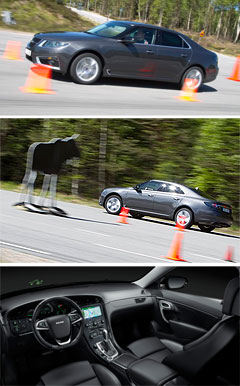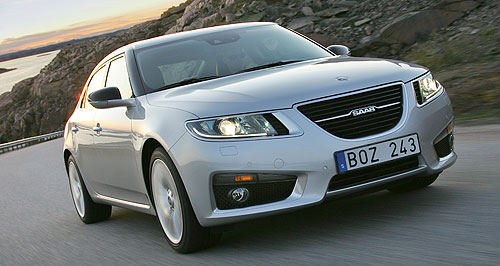Future models - Saab - 9-5First drive: Saab’s flagship sets sailTesting times: Aussie Saab enthusiast Steven Wade gets behind the wheel of the new Saab 9-5 in Sweden. Saab goes bigger but better with 9-5 as it lays its future on the production line21 Jun 2010 By STEVEN WADE HOBART Saab enthusiast, blogger and ‘Save Saab’ international campaign coordinator Steven Wade was invited to the global launch of Saab’s 9-5 in Sweden, where he sampled the first new product to roll off the production line at Trollhattan since Saab was saved from oblivion by Spyker Cars NV. Here are his impressions for GoAuto: THE phrase “end of the line” had a dark meaning for Saab owners, enthusiasts and employees last December, when General Motors was planning to close the Swedish company. Instead, GM reversed its decision, choosing to sell Saab to Spyker Cars, a Dutch sports car company. Today, “end of the line” could refer to the giant glass wall Saab has built at the end of its Trollhattan production line, where visitors can watch the new Saab 9-5 being built. They call this the Saab Launch Centre and it was here that Saab’s new corporate owner, Victor Muller, and the company’s managing director, Jan-Ake Jonsson, spelled out the future of the company at the 9-5 launch. That a tiny company like Saab has a tough road ahead in what is normally a supersized automotive world is a given. The new owners, however, have a good head start. For a purchase price of $US74 million ($A84m) in cash and $US326 million ($A370m) in preferred non-voting stock, Spyker’s Mr Muller received a fully functioning car company, complete with three fully developed vehicles ready for release and one more funded to completion. The first of these new vehicles is the new Saab 9-5 sedan – an all-new vehicle after nearly 13 years with only evolutions of the 1998 original.  While the 9-5 is built on GM’s Epsilon II global architecture, it shares only 30 per cent of its parts with GM vehicles built on the same platform. While the 9-5 is built on GM’s Epsilon II global architecture, it shares only 30 per cent of its parts with GM vehicles built on the same platform.Saab was often criticised for having two models that were too close in size – the 9-3 and 9-5. That criticism is now moot, as the new 9-5 is a significantly larger vehicle at a hair over five metres long. It seats five in comfort, although tall rear seat passengers might feel slightly claustrophobic if the car is equipped with the optional oversized sunroof. Saab has long been well regarded for its seats, and the new 9-5 is no exception. Base model seats are quite comfortable, with a combination of leather and textile facings. My test vehicle, a top of the range (and fully loaded) Aero, had seats that were sublime, with perforated leather facings, heating and ventilation, as well as electric adjustment and memory settings. Front seats are fitted with Saab’s new third-generation active head restraints to protect occupants from whiplash. The 9-5’s interior was a point of contention at the launch event. Show cars that went on display at the Frankfurt motor show in September last year were fitted with neat, sophisticated paneling on the dashboard. Supplier problems have meant that this dash panel is not fitted to the first-run vehicles being made in Trollhattan. The result is a well designed unit that looks plain in basic black. Saab says it is working on making more visually engaging versions available as soon as possible. Storage is generous, with plenty of cubby holes, pockets and holders in the cabin and a cavernous boot equipped with Saab’s U-rail storage system. As the name suggests, this system involves a U-shaped track in the floor of the boot. A telescopically extendable barrier can be moved about the track, dividing the boot into segments where more fragile items can be protected from other items moving about when the car is in motion. The new Saab 9-5 will be available with five different engine options, depending on market suitability. Petrol models will include a 1.6 Turbo, producing 132kW, a 2.0 (BioPower) Turbo that will be E85-capable in most markets and will produce 162kW and a 2.8-litre V6 Turbo tuned to produce 221kW and 400Nm. Diesel offerings include a single-turbo 2.0 TiD and a twin turbo TTiD of the same size, producing 118kW and 140kW respectively. My time in the 9-5 was restricted to two days driving the 2.0T and 2.8T petrol engines. Both cars were equipped with Saab’s XWD (cross-wheel drive) system sourced from Haldex and first seen in the 9-3 Turbo X from 2008. Uprated and 10mm lower sports suspension systems were also fitted, as is standard with XWD. The highest spec 2.8T gets Saab’s new HiPerStrut front suspension, which acts similar to a double wishbone arrangement. The 2.0T gets MacPherson struts in front. Both cars were fitted with a new H-arm suspension at rear, which uses a double-isolated subframe to reduce vibration and improve roadholding. Non-XWD versions of the four-cylinder models will get a more regulation four-link rear suspension. On the road, the 2.8T V6 Aero delivers smooth power through its six-speed automatic transmission. Manual shifting is available via either the stick or the paddleshifters behind the flat-bottomed sports steering wheel. At about 2000kg, this is quite a heavy vehicle, but the Australian-sourced V6 can still push the car from rest to 100 km/h in under seven seconds. Acceleration at speed is impressive, with the 9-5 zooming from 80-120Km/h and beyond in the blink of an eye. Saab has used the 9-5 to introduce a new real-time damping and dynamics control system called DriveSense, which allows you to select between Comfort, Sport and Intelligent modes. Comfort and Sport modes slot you directly into either comfortable, soft and economical driving or more aggressive, sporty driving. Intelligent mode responds to inputs from the car and adjusts damping, steering and throttle responses to suit. The difference between Comfort and Sport modes is significant, with the car responding with an agility that defies its size when Sport mode is engaged. Day two of the 9-5 drive program saw the press corps head to a Volvo facility at Hallerad, to a handling track comprising a series of sweeping and tightening bends and chicanes. The exercise was made particularly interesting by persistent rain, leading to a convincing demonstration of Saab’s XWD system. Driving bends on this wet track at speeds upwards of 140 km/h revealed nothing but total stability as the XWD system distributed engine power among all four wheels as required. My laps with Saab engineer Stefan Lunquist even involved some deliberate attempts to induce oversteer at about 120km/h by quickly jagging the steering wheel to one side. The XWD system shifts power front and rear, and on the rear wheels it uses an electronic limited-slip differential to shift power from side to side. The result in our oversteer demonstration was akin to a pair of carving skis the distribution of power making the tyres ‘cut’ into the road surface, showing incredible grip as the car suddenly shifted from one direction to the other on the wet tarmac. For all its mechanical innovation and apparent agility, however, I couldn’t help but feel a little disconnected from the driving experience in the 2.8T V6 Aero. All of the assistance in the world couldn’t hide the fact that this is a heavy car, and its sheer mass tends to deaden the driving experience just a little more than this enthusiast would prefer. The big Saab does make for an excellent long distance cruiser, however, eating up the road in total comfort on our longer drives between Trollhattan and Gothenburg. There is nearly 500kg difference between the heaviest Saab 9-5 and the lightest. The 2.0T XWD falls somewhere in between. The 2.0T is Saab’s first engine fitted with direct injection. The specifications read like it might be ill-equipped to handle the 9-5’s mass, but so responsive is this engine that it moves the car to 100 km/h only one second slower than the V6. The engine’s flexibility, combined with reduced weight, leads to a surprisingly responsive car that involves the driver quite a bit more than the big V6 and makes the spacious 9-5 feel considerably smaller in the bends. Gearshifts in the six-speed manual are not quite rifle-bolt sharp, but represent a definite improvement over older Saab shifters. Likewise, the ‘manual’ shifts on the automatic transmission are much quicker than previous Saab paddle shifters. Saab has packed a lot of new technology into this car – technology that would not have been economically feasible to introduce to the outgoing model, but which potential 9-5 owners will expect in this class of vehicle. These include a head-up display that projects speed and navigation instructions on to the windscreen. The premium entertainment system gets you an eight-inch touchscreen, Harmon Kardon true 5.1 surround sound, 10GB of in-car music storage, DVD player and wireless headphones so kids can watch their DVD on the rear seat screens in peace and quiet. There is USB connectivity and control for external music players. Other features include Bi-Xenon Smart Beam headlamps, a fully loaded trip computer including tyre pressure monitor, Traffic Signal Recognition, Lane Departure Warning, Advanced Park Assist, Keyless entry and exit, keyless idle-stop, tri-zone climate control and Saab’s brilliant night panel function, which dims all instrumentation except for the speedometer at night (warning lights come on as needed). Saab has worked hard on the design and integration of all this electronic gadgetry. The results make for a seamless and intuitive experience that compliments driving rather than distracting from it. Safety is first class in the 9-5, as is normally the case with Swedish cars. As well as the XWD system and other passive safety features, the 9-5 comes with a five-star Euro NCAP crash test rating and a full complement of airbags, including longer side curtain airbags as part of a new rollover protection system. The new Saab 9-5 is the most technically advanced Saab ever made and a pretty good driver, too, but it isn’t perfect. It is, however, a great launch pad for a company that is rebuilding its reputation after years of brand dilution and a 2009 where the company was literally one poor decision away from extinction.  Read more2nd of June 2010  Saab’s 9-5 grows upSpacious Saab flagship comes out swinging for Saab’s survival after cheating death26th of March 2010  Saab 9-5 still on iceBuyers can order new 9-5 in Europe, but Saab remains in limbo Down Under |
Click to shareSaab modelsResearch Saab Motor industry news |















Facebook Twitter Instagram